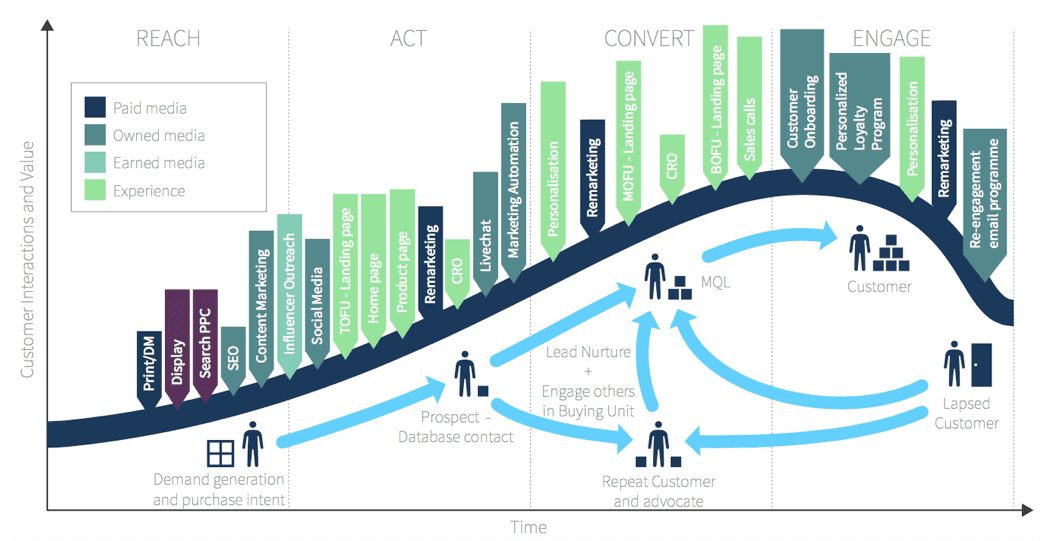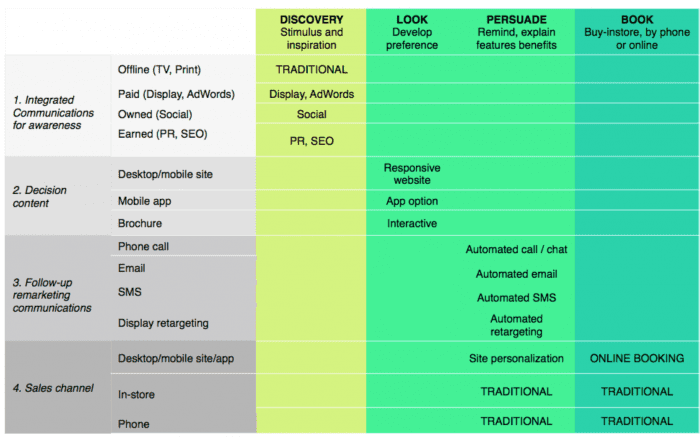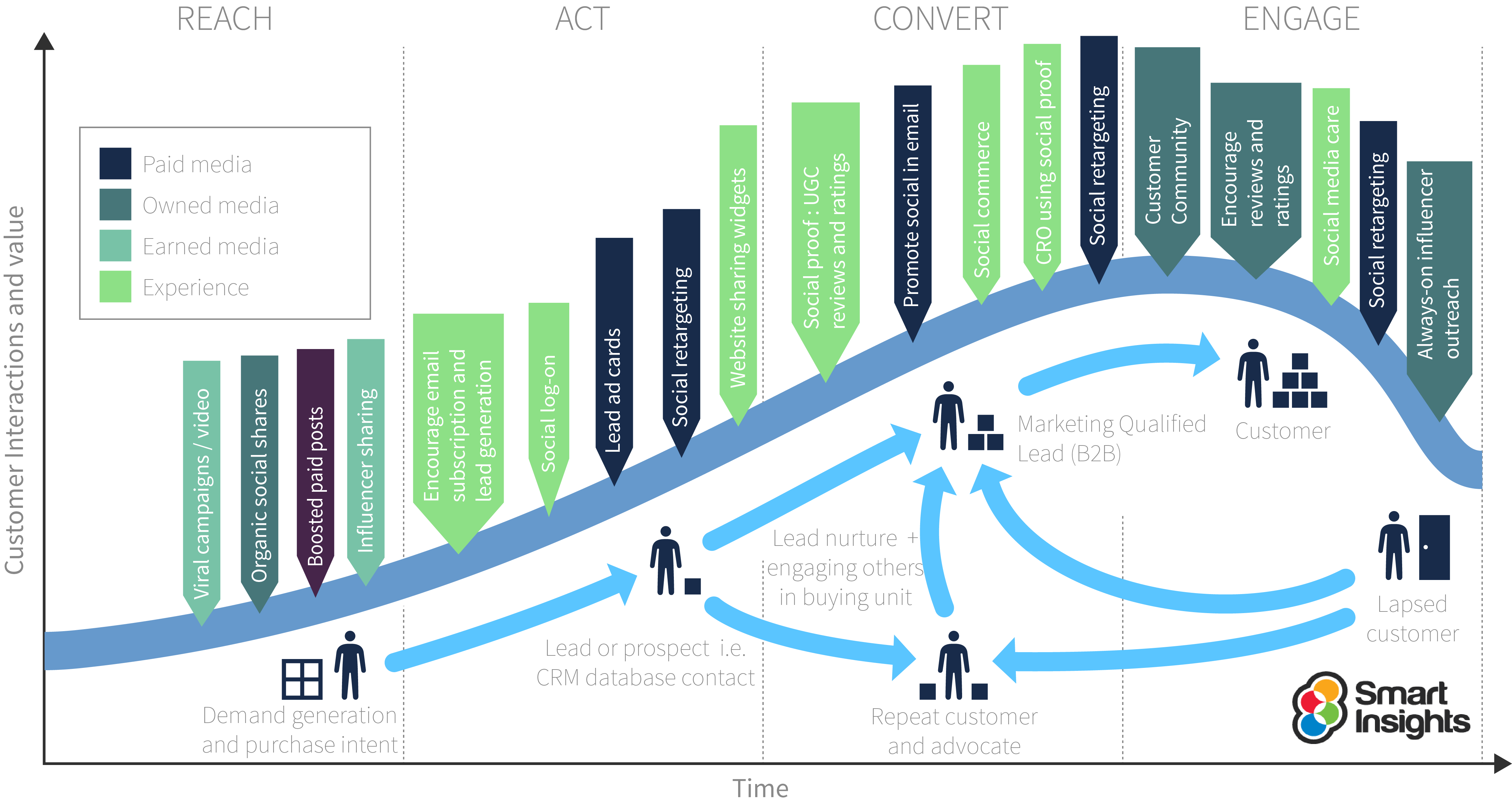Create a co-ordinated 'always-on' digital marketing strategy for the whole customer lifecycle to boost conversions and retention
It's no secret that engaging your customers is crucial to achieving continued sales, and it's also well known that it is usually far easier and costs less to get repeat business from existing customers than it is to acquire new ones from scratch.
Customer relationship management (CRM) is well established as a process to try to achieve this, but this customer lifecycle 'relationship' begins with the first contact with the customer (when they are still a contact or prospect).
We believe that the best way for a company or brand to build relationships is through a planned always-on marketing approach integrated across each 4 stages of your customers' lifecycles:
- Reach
- Act
- Convert
- Engage
This renewed focus by marketers on prospect and customer engagement, conversion, and retention has led to the appearance of a new phase in the digital marketing lexicon: Customer lifecycle marketing, or sometimes just lifecycle marketing.
What is customer lifecycle marketing?
We define customer lifecycle marketing as:
Creating a managed communications or contact strategy to prioritise and integrate the full range of marketing communications channels and experiences to support prospects and customers on their path-to-purchase using techniques such as persuasive personalised messaging and re-targeting.
This blog features 2 simple visual definitions of lifecycle marketing - defining B2B and B2C marketing lifecycles. We then look at examples of how the analysis can be applied to individual channels like email marketing and social media marketing.
Free Members can use our Free digital marketing plan template to review the gap between the lifecycle activities you could be working on and the ones you are currently, to identify and prioritize improvements.
Free digital marketing plan template
Our popular marketing planning template is structured across the Smart Insights RACE Framework. Join Smart Insights as a Free Member to download our digital marketing plan template today
Access the Free digital marketing plan template
How do you analyze a customer's journey from discovery to purchase and loyalty?
To help show the importance of understanding customer journeys when managing communications, our RACE funnel highlights some of the many online marketing channels you must integrate to get the best results from digital marketing today.
While some channels such as social media and SEO are well known we find that some always-on marketing techniques such as remarketing and influencer outreach are used less widely.
We're fortunate today to have many martech options for marketing automation, so we can create a co-ordinated lifecycle contact strategy to engage audiences through:
- Automated email marketing like welcome, nurture and win-back sequences
- Display ad retargeting, e.g. via Google Ads Display Network remarketing
- On-site personalization recommending next best product, offer, or content to convert
- Social media retargeting is available on Facebook, Instagram, Twitter and LinkedIn
- Traditional channels like direct mail or phone contact
If you're looking for digital marketing examples, don't miss our free explainer featuring 18 key digital marketing techniques, defined across the RACE Framework.
Below, we look at different lifecycle examples that measure stages of customer interactions and value over time across RACE.

B2C Customer Lifecycle example
This visual - developed for use as a 'gap analysis' in our training and consulting workshops - shows typical lifecycle marketing activities that need to be managed by retailers and e-commerce across the lifecycle and across our RACE Framework.

B2B Customer Lifecycle example
I have also created this summary of the lifecycle for B2B digital marketing activities since B2B marketing is different, with content marketing much more important to demand generation.
Content creation for different personas is useful as part of demand generation at Top-of-funnel and then lead nurturing in the bottom of the funnel. Other marketing activities such as retargeting through email, Google Ads and LinkedIn can also be integrated within B2B.
Yet, I find when training, that often businesses are missing out on some of these activities which should be 'always-on'. It can be useful to create a 'gap analysis of your lifecycle' comparing the full lifecycle against.

Gap analysis showing actual B2B always-on activities used

What is the origin of the term 'customer lifecycle'?
Originally coined as a term to explain their services by the CRM provider Infusionsoft, customer lifecycle marketing promises to help you to design a marketing plan to attract customers, grow sales and deliver great experiences. They break it down into three stages: 'attract', 'sell', 'wow'.
 We think Infusionsoft's customer lifecycle model is great for thinking about the value of your customers over longer periods, rather than reducing everything down to a simple conversion of each contact, it is often quite light on details such as what exactly the different steps entail. We're not complaining - Infusionsoft are a great CRM - we should know, we used to use them (Full transparency, we since moved to Salesforce / Pardot) - we just think we can add some additional insights.
We think Infusionsoft's customer lifecycle model is great for thinking about the value of your customers over longer periods, rather than reducing everything down to a simple conversion of each contact, it is often quite light on details such as what exactly the different steps entail. We're not complaining - Infusionsoft are a great CRM - we should know, we used to use them (Full transparency, we since moved to Salesforce / Pardot) - we just think we can add some additional insights.
Defining contacts in lifecycle email marketing
In reality, lifecycle communication involves a huge number of touch points across the customer journey to achieve different goals with different types of emails, as shown by this visual from Kath Pay, consultant at Holistic Email Marketing.

Looking at the potential of the full lifecycle above shows that it's important to 'mind the gap', to review all contacts and to think where you can use new types of comms or improve existing ones. Kath covers best practices for these in our new resource to help businesses improve their lifecycle marketing.
The chart below also shows how different channels can be utilized across different stages of the buyer's journey. Critical to consider when formulating a lifecycle marketing plan.

Defining customer lifecycle strategy
Lifecycle marketing, as its name suggests, involves studying the whole customer journey in an integrated way, from first contact to customer relationship management rather than narrowly focusing on a given campaign, channel or metric. Instead of focusing on separate campaigns, you should use an 'always-on' approach to marketing look as your customer's entire journey, across all devices and channels, and optimise your messaging to align with the various touch points along that journey. Because lifecycle marketing works across platforms, it is key the different teams running different aspects of your marketing can collaborate and all pull in the same direction when applying a lifecycle marketing strategy. To start with, everyone needs to be on the same page and understand exactly what customer lifecycle marketing entails. Below are some definitions of lifecycle marketing from different departments/business types.
Email Marketing:
"Lifecycle marketing intergrates your ecommerce and email databases to generate highly personlised messages for your customers" - Kath Pay, Email Marketing Expert
CRM:
"Customer life cycle is a term used to describe the progression of steps a customer goes through when considering, purchasing, using, and maintaining loyalty to a product or service" - Margaret Rouse, Tech Target
Academic:
The customer life cycle describes the points in the continuum where you: 1) Claim someones attention. 2) Bring them into your sphere of influence. 3) Turn them into a registered and/or paying customer. 4) Keep them as a customer. 5) Turn them into a company advocate. - Sterne and Cutler, aurthors of the paper introducing the concept of the customer lifecycle back in 2000
Ecommerce:
"Customer lifecycle marketing (CLM) is an approach to customer communication that recognises that different stages on the journey to becoming a loyal, active customer require different marketing messages and strategies." - Ometria, Ecommerce analyitics software
Customer personalization
The definitions differ slightly from one another because of the different angles the various writers have attacked the problem from. However, almost all point to some form of personalization being key to effective customer lifecycle marketing. This it crucial to get right, as effective personalization brings a host of benefits which can help you increase sales and retention, which after all are the objects of any customer lifecycle marketing plan.

One key benefit of personalizing messages is that it recognizes the customers as individuals. By marketing one way to prospects, another way to those that have already purchased a product and another way to long-term, high-value customers you can make your marketing messages far more compelling and effective. Customers will also appreciate the personal touch, and you'll stop them driving them away by bombarding them with messages which aren't relevant to them.
A second key benefit of personalizing messages via a customer lifecycle model is that they can align with the point in the lifecycle that the potential customer is currently in. Marketing messages from the brand which recognize where the customers are in their individual lifecycles and thus can tailor messages much more effectively. Taking a SaaS business as an example, it's no good asking someone who has just signed up to a mailing list to find out more to buy your ultra-premium business level product straight away, and similarly its probably not worth trying to push customers that have shown interest in the high level business product towards your free basic trial option.
Email Marketing
Customer lifecycle marketing applies to all areas of marketing, but it is particularly important to consider email marketing, because email offers a unique ability to contact your customers at given moments with personalized messages.
When done correctly, personalized email messages combine all kinds of data to deliver mails which are extremely relevant and useful to the customer. Below is an example of a personalized email right done right.

It's important to consider how you can optimize your email messaging at certain key touchpoints across the customer journey, and therefore taking a step back and looking at the whole customer journey is a must.
Applying lifecycle-thinking to social media marketing
Social media are one of the most powerful digital marketing channels since they can be applied through the customer lifecycle with these aims:
- Reach: Organic and paid social updates to create awareness including through lookalike targeting
- Act: Paid social options to generate leads
- Convert: Retargeting options at an individual level to increase conversion
- Engage: Customer communications through organic updates, retargeting, and uploading customer lists to reach known customers
This lifecycle visual summarizes the options for using paid and organic social across RACE.
 Like the other visuals in the post, it can be used for a simple 'gap analysis' in a workshop to review how you are using social media. It helps prove how a combination of paid and organic social are needed to gain the best coverage across the lifecycle.
Like the other visuals in the post, it can be used for a simple 'gap analysis' in a workshop to review how you are using social media. It helps prove how a combination of paid and organic social are needed to gain the best coverage across the lifecycle.
If you're considering next steps to improve the lifecycle your customers experience with your brand, why not download our free Digital marketing plan template? With RACE you can apply a data-driven approach to track and measure your customers' lifecycles in real time.
Free digital marketing plan template
Our popular marketing planning template is structured across the Smart Insights RACE Framework. Join Smart Insights as a Free Member to download our digital marketing plan template today
Access the Free digital marketing plan template


















